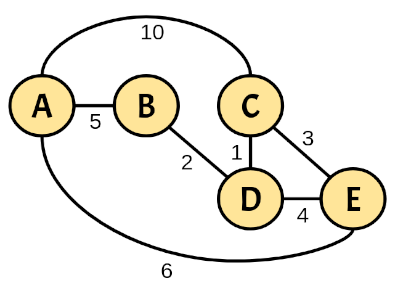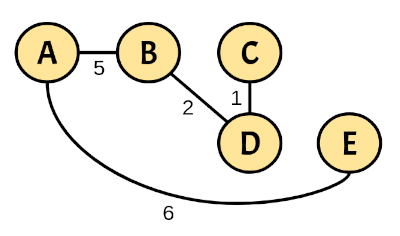
Lab #6: Dijkstra’s Shortest-Path Tree
Objective
During this activity, students will be able to:
- Implement Dijkstra’s algorithm in order to build a graph’s shortest-path tree starting in a given vertex.
Description
This activity must be developed in the pre-assigned teams of two.
In a file called dijkstra.py, write a Python function called dijkstra_spt that takes as input an initial vertex and a connected undirected weighted graph. The function uses Dijkstra’s algorithm to find the shortest-path between the initial vertex and all the other graph’s vertices. The function returns a tuple with two items:
- A costs dictionary where each key \(k\) is a vertex and its associated value is the cost of going from the initial vertex to the vertex \(k\).
- The resulting spanning tree with the shortest-path from the initial vertex to every other one.
For example, given the following weighted graph:

The resulting costs dictionary with initial vertex A is:
| Vertex | Cost |
|---|---|
| A | 0 |
| B | 5 |
| C | 8 |
| D | 7 |
| E | 6 |
The graph that represents the shortest-path spanning tree is:

This is how the dijkstra_spt function should be called:
dijkstra_spt('A', {'A': {('B', 5), ('C', 10), ('E', 6)}, 'B': {('A', 5), ('D', 2)}, 'C': {('A', 10), ('D', 1), ('E', 3)}, 'D': {('B', 2), ('C', 1), ('E', 4)}, 'E': {('A', 6), ('C', 3), ('D', 4)}, })
Note that strings are used to represent the vertices, while the graph is represented as a dictionary where each key is a string and its associated value is a set of tuples (the vertex’s neighbours) containing a string and a number (the respective edge’s weight).
The previous function call returns the following result:
({'A': 0, 'B': 5, 'C': 8, 'D': 7, 'E': 6}, {'A': {('B', 5), ('E', 6)}, 'B': {('A', 5), ('D', 2)}, 'C': {('D', 1)}, 'D': {('B', 2), ('C', 1)}, 'E': {('A', 6)}})
Use the following code as a starting point:
# File: dijkstra.py WeightedGraph = dict[str, set[tuple[str, float]]] def dijkstra_spt( initial: str, graph: WeightedGraph) -> tuple[dict[str, float], WeightedGraph]: # The function's code goes here ...
Test your program using the following unit tests:
# File: dijkstra_spt_test.py from unittest import TestCase, main from dijkstra import dijkstra_spt, WeightedGraph biggie: WeightedGraph = { 'A': {('B', 4), ('E', 8)}, 'B': {('A', 4), ('E', 11), ('C', 8)}, 'C': {('B', 8), ('I', 2), ('G', 4), ('D', 7)}, 'D': {('C', 7), ('G', 14), ('H', 9)}, 'E': {('A', 8), ('B', 11), ('I', 7), ('F', 1)}, 'F': {('E', 1), ('I', 6), ('G', 2)}, 'G': {('F', 2), ('C', 4), ('D', 14), ('H', 10)}, 'H': {('D', 9), ('G', 10)}, 'I': {('C', 2), ('E', 7), ('F', 6)}, } class Testdijkstra_spt(TestCase): def test_dijkstra_spt_1(self): self.assertEqual( ({'A': 0, 'B': 1}, {'A': {('B', 1)}, 'B': {('A', 1)}}), dijkstra_spt('A', { 'A': {('B', 1)}, 'B': {('A', 1)} })) def test_dijkstra_spt_2(self): self.assertEqual( ({'A': 0, 'B': 1, 'C': 1}, {'A': {('B', 1), ('C', 1)}, 'B': {('A', 1)}, 'C': {('A', 1)}}), dijkstra_spt('A', { 'A': {('B', 1), ('C', 1)}, 'B': {('A', 1), ('C', 2)}, 'C': {('A', 1), ('B', 2)}, })) def test_dijkstra_spt_3(self): self.assertEqual( ({'A': 1, 'B': 1, 'C': 1, 'D': 1, 'E': 0}, {'A': {('E', 1)}, 'B': {('E', 1)}, 'C': {('E', 1)}, 'D': {('E', 1)}, 'E': {('A', 1), ('B', 1), ('C', 1), ('D', 1)}}), dijkstra_spt('E', { 'A': {('B', 1), ('C', 1), ('D', 1), ('E', 1)}, 'B': {('A', 1), ('C', 1), ('D', 1), ('E', 1)}, 'C': {('A', 1), ('B', 1), ('D', 1), ('E', 1)}, 'D': {('A', 1), ('B', 1), ('C', 1), ('E', 1)}, 'E': {('A', 1), ('B', 1), ('C', 1), ('D', 1)} })) def test_dijkstra_spt_4(self): self.assertEqual( ({'A': 0, 'B': 1, 'C': 3, 'D': 6, 'E': 10}, {'A': {('B', 1)}, 'B': {('A', 1), ('C', 2)}, 'C': {('B', 2), ('D', 3)}, 'D': {('C', 3), ('E', 4)}, 'E': {('D', 4)}}), dijkstra_spt('A', { 'A': {('B', 1)}, 'B': {('A', 1), ('C', 2)}, 'C': {('B', 2), ('D', 3)}, 'D': {('C', 3), ('E', 4)}, 'E': {('D', 4)} })) def test_dijkstra_spt_5(self): self.assertEqual( ({'A': 6, 'B': 4, 'C': 5, 'D': 1, 'E': 0}, {'A': {('B', 2)}, 'B': {('A', 2), ('D', 3)}, 'C': {('E', 5)}, 'D': {('B', 3), ('E', 1)}, 'E': {('C', 5), ('D', 1)}}), dijkstra_spt('E', { 'A': {('B', 2), ('C', 4)}, 'B': {('A', 2), ('D', 3)}, 'C': {('A', 4), ('E', 5)}, 'D': {('B', 3), ('E', 1)}, 'E': {('C', 5), ('D', 1)} })) def test_dijkstra_spt_6(self): self.assertEqual( ({'A': 0, 'B': 5, 'C': 8, 'D': 7, 'E': 6}, {'A': {('B', 5), ('E', 6)}, 'B': {('A', 5), ('D', 2)}, 'C': {('D', 1)}, 'D': {('B', 2), ('C', 1)}, 'E': {('A', 6)}}), dijkstra_spt('A', { 'A': {('B', 5), ('C', 10), ('E', 6)}, 'B': {('A', 5), ('D', 2)}, 'C': {('A', 10), ('D', 1), ('E', 3)}, 'D': {('B', 2), ('C', 1), ('E', 4)}, 'E': {('A', 6), ('C', 3), ('D', 4)}, })) def test_dijkstra_spt_7(self): self.assertEqual( ({'A': 0, 'B': 4, 'C': 12, 'D': 19, 'E': 8, 'F': 9, 'G': 11, 'H': 21, 'I': 14}, {'A': {('B', 4), ('E', 8)}, 'B': {('A', 4), ('C', 8)}, 'C': {('B', 8), ('D', 7), ('I', 2)}, 'D': {('C', 7)}, 'E': {('A', 8), ('F', 1)}, 'F': {('E', 1), ('G', 2)}, 'G': {('F', 2), ('H', 10)}, 'H': {('G', 10)}, 'I': {('C', 2)}}), dijkstra_spt('A', biggie)) def test_dijkstra_spt_8(self): self.assertEqual( ({'A': 19, 'B': 15, 'C': 7, 'D': 0, 'E': 14, 'F': 13, 'G': 11, 'H': 9, 'I': 9}, {'A': {('B', 4)}, 'B': {('A', 4), ('C', 8)}, 'C': {('B', 8), ('D', 7), ('G', 4), ('I', 2)}, 'D': {('C', 7), ('H', 9)}, 'E': {('F', 1)}, 'F': {('E', 1), ('G', 2)}, 'G': {('C', 4), ('F', 2)}, 'H': {('D', 9)}, 'I': {('C', 2)}}), dijkstra_spt('D', biggie)) def test_dijkstra_spt_9(self): self.assertEqual( ({'A': 21, 'B': 22, 'C': 14, 'D': 9, 'E': 13, 'F': 12, 'G': 10, 'H': 0, 'I': 16}, {'A': {('E', 8)}, 'B': {('C', 8)}, 'C': {('G', 4), ('B', 8), ('I', 2)}, 'D': {('H', 9)}, 'E': {('F', 1), ('A', 8)}, 'F': {('E', 1), ('G', 2)}, 'G': {('C', 4), ('H', 10), ('F', 2)}, 'H': {('D', 9), ('G', 10)}, 'I': {('C', 2)}}), dijkstra_spt('H', biggie)) def test_dijkstra_spt_10(self): self.assertEqual( ({'A': 14, 'B': 10, 'C': 2, 'D': 9, 'E': 7, 'F': 6, 'G': 6, 'H': 16, 'I': 0}, {'A': {('B', 4)}, 'B': {('A', 4), ('C', 8)}, 'C': {('B', 8), ('D', 7), ('G', 4), ('I', 2)}, 'D': {('C', 7)}, 'E': {('I', 7)}, 'F': {('I', 6)}, 'G': {('C', 4), ('H', 10)}, 'H': {('G', 10)}, 'I': {('C', 2), ('E', 7), ('F', 6)}}), dijkstra_spt('I', biggie)) if __name__ == '__main__': main()
Finally, make sure no type or PEP 8 style errors are produced by using the mypy and pycodestyle linters. You can incorporate these tools into VS Code or you can run them at the terminal.
Deliverables
Place in a comment at the top of the dijkstra.py source file the authors’ personal information (student ID and name), for example:
#---------------------------------------------------------- # Lab #6: Dijkstra’s Shortest-Path Tree # # Date: 18-Oct-2022 # Authors: # A01770771 Kamala Khan # A01777771 Carol Danvers #----------------------------------------------------------
Upload Instructions
To deliver the dijkstra.py file, please provide the following information:
Only one team member needs to upload the file.
Due date is Tuesday, October 18.